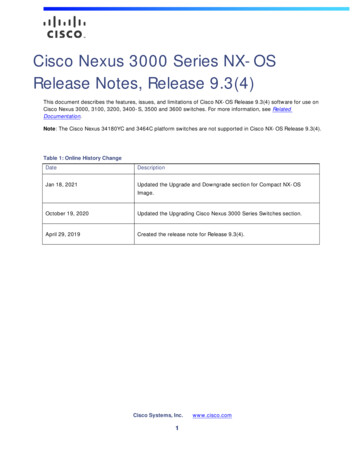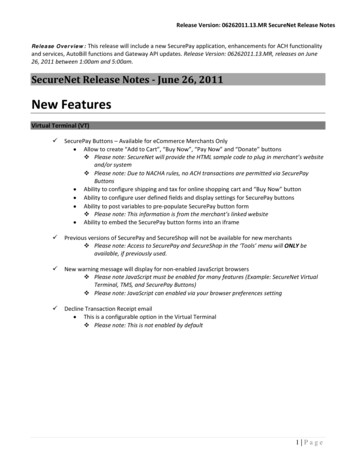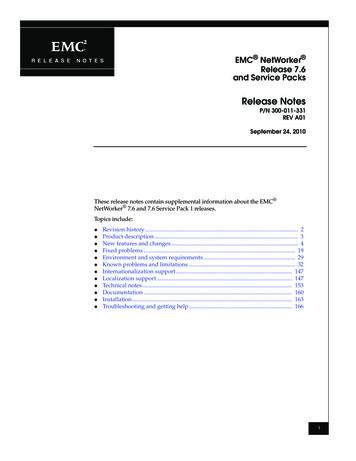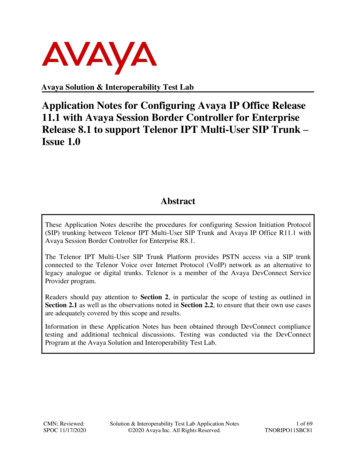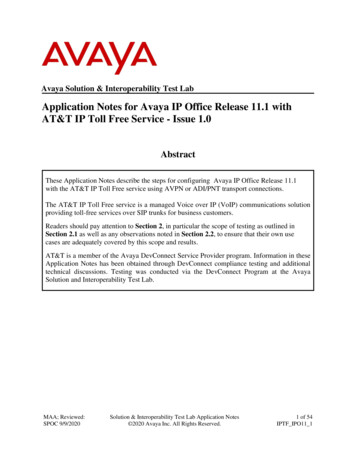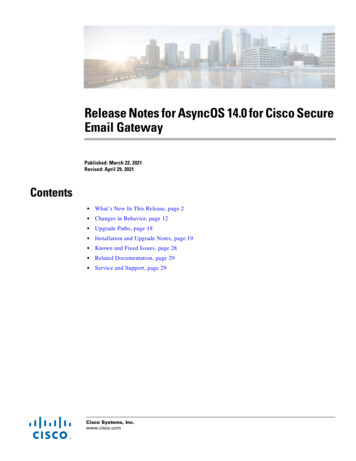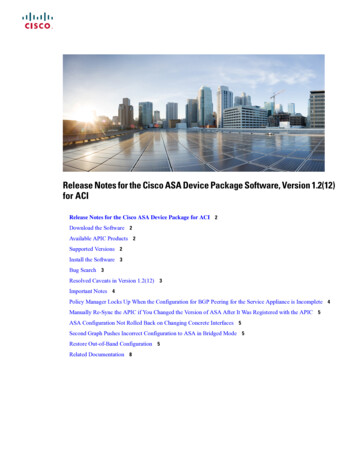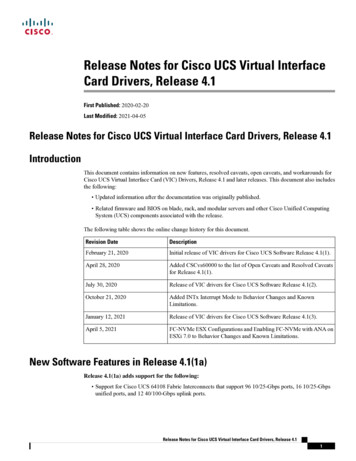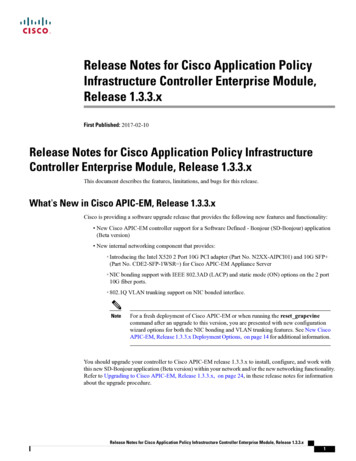
Transcription
Release Notes for Cisco Application PolicyInfrastructure Controller Enterprise Module,Release 1.3.3.xFirst Published: 2017-02-10Release Notes for Cisco Application Policy InfrastructureController Enterprise Module, Release 1.3.3.xThis document describes the features, limitations, and bugs for this release.What’s New in Cisco APIC-EM, Release 1.3.3.xCisco is providing a software upgrade release that provides the following new features and functionality: New Cisco APIC-EM controller support for a Software Defined - Bonjour (SD-Bonjour) application(Beta version) New internal networking component that provides: Introducing the Intel X520 2 Port 10G PCI adapter (Part No. N2XX-AIPCI01) and 10G SFP (Part No. CDE2-SFP-1WSR ) for Cisco APIC-EM Appliance Server NIC bonding support with IEEE 802.3AD (LACP) and static mode (ON) options on the 2 port10G fiber ports. 802.1Q VLAN trunking support on NIC bonded interface.NoteFor a fresh deployment of Cisco APIC-EM or when running the reset grapevinecommand after an upgrade to this version, you are presented with new configurationwizard options for both the NIC bonding and VLAN trunking features. See New CiscoAPIC-EM, Release 1.3.3.x Deployment Options, on page 14 for additional information.You should upgrade your controller to Cisco APIC-EM release 1.3.3.x to install, configure, and work withthis new SD-Bonjour application (Beta version) within your network and/or the new networking functionality.Refer to Upgrading to Cisco APIC-EM, Release 1.3.3.x, on page 24, in these release notes for informationabout the upgrade procedure.Release Notes for Cisco Application Policy Infrastructure Controller Enterprise Module, Release 1.3.3.x1
Release Notes for Cisco Application Policy Infrastructure Controller Enterprise Module, Release 1.3.3.xCisco APIC-EM System RequirementsCautionWith this Cisco APIC-EM, 1.3.3.x release version, the IWAN application is not bundled with the APIC-EMbase ISO image. It will need to be explicitly downloaded from Cisco.com and then installed on an existingAPIC-EM deployment (Release 1.3.3.x). To deploy the IWAN application on the controller, see InstallingCisco APIC-EM Applications, on page 25. For information about the correct upgrade path to follow tomaintain the IWAN application already installed on your controller, as well as the upgrade procedure tofollow, see Upgrading to Cisco APIC-EM, Release 1.3.3.x, on page 24.Cisco APIC-EM System RequirementsCisco offers a physical appliance that can be purchased from Cisco with the ISO image pre-installed andtested. The Cisco APIC-EM can also be installed and operate within a dedicated physical server (bare-metal)or a virtual machine within a VMware vSphere environment. The Cisco APIC-EM has been tested and qualifiedto run on the following Cisco UCS servers: Cisco UCS C220 M4S Server Cisco UCS C220 M3S Server Cisco UCS C22 M3S ServerIn addition to the above servers, the Cisco APIC-EM may also run on any Cisco UCS servers that meet theminimum system requirements (see Cisco APIC-EM Physical Server Requirements, on page 2). We alsosupport running the product in a virtual machine that meets the minimum system requirements on VMwarevSphere (see Cisco APIC-EM VMware vSphere Requirements, on page 4).NoteThe Ubuntu 14.04 LTS 64-bit operating system is included in the ISO image and a requirement for thesuccessful installation and operation of the Cisco APIC-EM. Prior to installing the Cisco APIC-EM onyour Cisco UCS server, click the following link and review the online matrix to confirm that your hardwaresupports Ubuntu 14.04 co APIC-EM Physical Server RequirementsThe following table lists the minimum system requirements for a successful Cisco APIC-EM server (bare-metalhardware) installation. Review the minimum system requirements for a server installation.NoteFor Cisco APIC-EM scale limits based upon the number of devices, hosts, and access points within yournetwork, see Cisco APIC-EM Requirements and Scale Limits, on page 6.The minimum system requirements for each server in a multi-host deployment are the same as in a single hostdeployment, except that the multi-host deployment requires two or three servers. Two servers are requiredfor software high availability. Three servers are required for both software and hardware high availability.With multiple servers (two or three servers), all of the servers must reside in the same subnet. For additionalinformation about a multi-host deployment, see Supported Multi-Host Configurations, on page 10.Release Notes for Cisco Application Policy Infrastructure Controller Enterprise Module, Release 1.3.3.x2
Release Notes for Cisco Application Policy Infrastructure Controller Enterprise Module, Release 1.3.3.xCisco APIC-EM Physical Server RequirementsCautionFor deploying on a physical server (bare metal), you must dedicate the entire server for the Cisco APIC-EM.You cannot use the server for any other software programs, packages, or data. During the Cisco APIC-EMinstallation, any other software programs, packages, or data on the server will be deleted.Table 1: Cisco APIC-EM Physical Server RequirementsPhysical Server OptionsServer image formatBare Metal/ISOHardwareCPU (cores)6 (minimum)NoteCPU (speed)2.4 GHzMemory32 GB (minimum)NoteNetworking6 CPUs is the minimumnumber required for yourserver. For betterperformance, werecommend using 12CPUs.For Cisco APIC-EM scalelimits, see CiscoAPIC-EM Requirementsand Scale Limits, on page6.Disk Capacity500 GB of available/usable storageafter hardware RAIDRAID LevelHardware-based RAID at RAIDLevel 10Disk I/O Speed200 MBpsNetwork Adapter1Web AccessRequiredBrowserThe following browsers aresupported when viewing andworking with the Cisco APIC-EM: Google Chrome, version 50.0or later Mozilla Firefox, version 46.0or laterRelease Notes for Cisco Application Policy Infrastructure Controller Enterprise Module, Release 1.3.3.x3
Release Notes for Cisco Application Policy Infrastructure Controller Enterprise Module, Release 1.3.3.xCisco APIC-EM VMware vSphere RequirementsCisco APIC-EM VMware vSphere RequirementsYou must configure at a minimum 32 GB RAM for the virtual machine that contains the Cisco APIC-EMwhen a single host is being deployed. The single host server that contains the virtual machine must have thismuch RAM physically available.For a multi-host deployment (2 or 3 hosts), only 32 GB of RAM is required for each of the virtual machinesthat contains the Cisco APIC-EM. Two servers are required for software high availability. Three servers arerequired for both software and hardware high availability. With multiple servers (two or three servers), all ofthe servers must reside in the same subnet. For additional information about a multi-host deployment, seeSupported Multi-Host Configurations, on page 10.NoteFor Cisco APIC-EM scale limits based upon the number of devices, hosts, and access points within yournetwork, see Cisco APIC-EM Requirements and Scale Limits, on page 6.NoteAs with running an application on any virtualization technology, you might observe a degradation inperformance when you run the Cisco APIC-EM in a virtual machine compared to running the CiscoAPIC-EM directly on physical hardware.Table 2: Cisco APIC-EM VMware vSphere RequirementsVirtual Machine OptionsVMware ESXi Version5.1/5.5/6.0Server Image FormatISOVirtual CPU (vCPU)6 (minimum)NoteDatastores6 vCPUs is the minimumnumber required for yourvirtual machineconfiguration. For betterperformance, werecommend using 12vCPUs.We recommend that you do notshare a datastore with any definedvirtual machines that are not partof the designated Cisco APIC-EMcluster.If the datastore is shared, then diskI/O access contention may occurand cause a significant reductionof disk bandwidth throughput anda significant increase of I/O latencyto the cluster.Release Notes for Cisco Application Policy Infrastructure Controller Enterprise Module, Release 1.3.3.x4
Release Notes for Cisco Application Policy Infrastructure Controller Enterprise Module, Release 1.3.3.xCisco APIC-EM VMware vSphere RequirementsHardware SpecificationsCPU (speed)2.4 GHzMemory32 GB (minimum)NoteNetworkingFor Cisco APIC-EM scalelimits, see CiscoAPIC-EM Requirementsand Scale Limits, on page6.Disk Capacity500 GBDisk I/O Speed200 MBpsNetwork Adapter1Web AccessRequiredBrowserThe following browsers aresupported when viewing andworking with the Cisco APIC-EM: Google Chrome, version 50.0or later Mozilla Firefox, version 46.0or laterNetwork TimingTo avoid conflicting time settings,we recommend that you disable thetime synchronization between theguest VM running the CiscoAPIC-EM and the ESXi host.Instead, configure the timing of theguest VM to a NTP server.ImportantEnsure that the timesettings on the ESXihost are alsosynchronized to theNTP server. This isespecially importantwhen upgrading theCisco APIC-EM.Failure to ensuresynchronization willcause the upgrade tofail.Release Notes for Cisco Application Policy Infrastructure Controller Enterprise Module, Release 1.3.3.x5
Release Notes for Cisco Application Policy Infrastructure Controller Enterprise Module, Release 1.3.3.xCisco APIC-EM Requirements and Scale LimitsVMware Resource PoolsWhen installing the Cisco APIC-EM on a VMware virtual machine, then we also recommend that you configureresource pools with the following settings. Resource Pools—CPU Resources: Shares—Normal Reservation—Minimum 14400 MHz Reservation Type—Expandable Limit—Maximum limit Resource Pools—Memory Resources: Shares—Normal Reservation—32 GB or 64 GB minimum depending upon your hardware Reservation Type—Expandable Limit—Maximum limitFor examples on how to create and configure both resource pools and a virtual machine for the Cisco APIC-EM,see Appendix B, "Preparing Virtual Machines for Cisco APIC-EM" in the Cisco Application PolicyInfrastructure Controller Enterprise Module Deployment Guide.Cisco APIC-EM Requirements and Scale LimitsThe following table lists the Cisco APIC-EM appliance requirements and scale limits for deployment.Release Notes for Cisco Application Policy Infrastructure Controller Enterprise Module, Release 1.3.3.x6
Release Notes for Cisco Application Policy Infrastructure Controller Enterprise Module, Release 1.3.3.xCisco APIC-EM Requirements and Scale LimitsTable 3: Cisco APIC-EM Appliance Requirements and Scale LimitsHardwareApplianceCores RAMAPIC-EM-APL-R-K9 10Hard Disk1RAID Network and Management I/O Scale Limits64 GB 4 X SAS HDD RAIDof 900 GB10each One 1GB Ethernetdedicated managementport 10,000NetworkDevice Two 1GB BASE-TEthernet LAN ports 10,000AccessPoints One RS-232 serial port(RJ-45 connector) One 15-pin VGA2connector 100,000Hosts Two USB3 3.0connectors One front-panel KVMconnector that is usedwith the KVM cable,which provides two USB2.0, one VGA, and oneserial (DB-9) connectorAPIC-EM-APL-G-K9 20128GB8 X SAS HDD RAIDof 900 GB10each One 1GB Ethernetdedicated managementport 10,000NetworkDevice Two 1GB BASE-TEthernet LAN ports 10,000AccessPoints One RS-232 serial port(RJ-45 connector) One 15-pin VGA2connector 100,000Hosts Two USB3 3.0connectors One front-panel KVMconnector that is usedwith the KVM cable,which provides two USB2.0, one VGA, and oneserial (DB-9) connector1 The Cisco SD-Bonjour application supports up to 10,000 network devices, 10,000 access points, and 100,000 hosts when installed with the controller on thesehardware appliances.Release Notes for Cisco Application Policy Infrastructure Controller Enterprise Module, Release 1.3.3.x7
Release Notes for Cisco Application Policy Infrastructure Controller Enterprise Module, Release 1.3.3.xCisco APIC-EM Requirements and Scale LimitsNoteThe supported scale limit numbers do not change if you deploy either a single host appliance or a multi-hostcluster (with up to three host appliances). The scale limit numbers are also the same for either theAPIC-EM-APL-R-K9 appliance or the APIC-EM-APL-G-K9 appliance. The reason for installing a largerappliance (APIC-EM-APL-G-K9) with 128 GB RAM is to plan and invest in the future of your network.The smaller appliance (APIC-EM-APL-R-K9) provides 64 GB RAM, which is enough for today's usecases, but the scale and number of applications used by the controller will increase over time.The following table lists the Cisco APIC-EM virtual machine requirements and scale limits for deployment.Table 4: Cisco APIC-EM Virtual Machine Requirements and Scale LimitsVirtualApplianceCoresCisco APIC-EM 12installed on aVirtual Machine(32 GB)2RAMHard DiskRAID32 GB200 GBRAID 10(configured onthe hardware)Scale Limits 500NetworkDevices 500AccessPoints 5000HostsCisco APIC-EM 8installed on aVirtual Machine(32 GB)32 GB200 GBRAID 10(configured onthe hardware) 200NetworkDevices 200AccessPoints 2000HostsCisco APIC-EM 6installed on aVirtual Machine(64 GB)64 GB500 GBRAID 10(configured onthe hardware) 1000NetworkDevices 1000AccessPoints 10,000HostsRelease Notes for Cisco Application Policy Infrastructure Controller Enterprise Module, Release 1.3.3.x8
Release Notes for Cisco Application Policy Infrastructure Controller Enterprise Module, Release 1.3.3.xCisco APIC-EM Requirements and Scale LimitsVirtualApplianceCoresCisco APIC-EM 10installed on aVirtual Machine(64 GB)32RAMHard DiskRAID64 GB4 X SAS HDD RAID 10of 900 GB each (configured onthe hardware)Scale Limits 10,000NetworkDevice 10,000AccessPoints 100,000HostsCisco APIC-EM 12installed on aVirtual Machine(64 GB)464 GB4 X SAS HDD RAID 10of 900 GB each (configured onthe hardware) 4,000NetworkDevice 4,000AccessPoints 40,000HostsCisco APIC-EM 20installed on aVirtual Machine(128 GB)5128 GB8 X SAS HDD RAID 10of 900 GB each (configured onthe hardware) 10,000NetworkDevice 10,000AccessPoints 100,000Hosts2 32 GB of RAM supports basic controller functionality, including Inventory, Discovery, Topology, Path Trace, EasyQoS and Network PnP.3 Cisco APIC-EM running on a virtual machine can scale up to the maximum number of supported devices, hosts, and access points (10,000 devices, 100,000hosts, and 10,000 access points) if the underlying hardware configuration for the virtual machine is the same as for a Cisco APIC-EM appliance(APIC-EM-APL-R-K9).4 Cisco APIC-EM running on a virtual machine can scale up to the maximum number of supported devices, hosts, and access points (10,000 devices, 100,000hosts, and 10,000 access points) if the underlying hardware configuration for the virtual machine is the same as for a Cisco APIC-EM appliance(APIC-EM-APL-R-K9).5 Cisco APIC-EM running on a virtual machine can scale up to the maximum number of supported devices, hosts, and access points (10,000 devices, 100,000hosts, and 10,000 access points) if the underlying hardware configuration for the virtual machine is the same as for a Cisco APIC-EM appliance(APIC-EM-APL-G-K9).Release Notes for Cisco Application Policy Infrastructure Controller Enterprise Module, Release 1.3.3.x9
Release Notes for Cisco Application Policy Infrastructure Controller Enterprise Module, Release 1.3.3.xSupported Multi-Host ConfigurationsSupported Multi-Host ConfigurationsThe Cisco APIC-EM supports a single host, two host, or three host cluster configuration. With a single hostconfiguration, 32 GB of RAM is required for that host. With a two or three host cluster configuration, 32 GBof RAM is required for each host in the cluster.NoteCisco APIC-EM does not support a cluster with more than three hosts. For example, a multi-host clusterwith five or seven hosts is not currently supported.The three host cluster provides both software and hardware high availability. The single or two host clusteronly provides software high availability and does not provide hardware high availability. For this reason, westrongly recommend that for a multi-host configuration three hosts be used.A hardware failure occurs when the physical host malfunctions or fails. A software failure occurs when aservice on a host fails. Software high availability involves the ability of the services on the hosts to be restartedand respun. For example, on a single host, if a service fails then that service is respun on that host. In a twohost cluster, if a service fails on one host then that service is re-spun on the remaining host. In a three hostcluster, if a service fails on one host, then that service is re-spun on one of the two remaining hosts.When setting up a two host or three host cluster, you should never set up the hosts to span a LAN across slowlinks. This may impact the recovery time if a service fails on one of the hosts. Additionally, when configuringeither a two host or three host cluster, all of the hosts in that cluster must reside in the same subnet.Cisco APIC-EM LicensingThe following are the licensing requirements for Cisco APIC-EM and its applications (apps): Cisco APIC-EM controller software and its basic apps (for example, Network PnP, Inventory, Topology,and EasyQoS): No fee-based license is required. The controller software and basic apps are offered at no cost tothe user. You can download the controller software (ISO Image) and run it on bare-metal Cisco UCS serversor run the ISO image on a virtual machine in a VMware ESXi environment. In both cases, youneed to ensure the required CPU, memory, and storage resources are available. Solution apps (for example, IWAN and any similar Cisco-developed solution app): A per-device license is required to run the solution apps. The solution apps licenses can only be acquired by purchasing Cisco Enterprise Management3.x device licenses, which also include the Cisco Prime Infrastructure licenses. The process foracquiring Cisco Prime Infrastructure 3.x device licenses is explained in the Cisco EnterpriseManagement Ordering Guide:Cisco Enterprise Management 3.x, Prime Infrastructure 3. x APIC-EM Ordering and LicensingGuidesRelease Notes for Cisco Application Policy Infrastructure Controller Enterprise Module, Release 1.3.3.x10
Release Notes for Cisco Application Policy Infrastructure Controller Enterprise Module, Release 1.3.3.xCisco APIC-EM Technical SupportNoteThe same license-acquisition process will also provide you with the right-to-use (RTU)licenses for APIC-EM solution apps. RTU licenses do not involve license files.Cisco APIC-EM Technical SupportThe following Cisco APIC-EM technical support options are provided: Cisco APIC-EM hardware appliance:Hardware support is provided through the Cisco SMARTnet Service. Cisco APIC-EM controller, basic apps, and services:Cisco TAC support is offered at no additional cost, if you have SMARTnet on any Cisco networkingdevice.NoteThe Cisco SD-Bonjour application for this release is a beta version; therefore, there isno TAC support for this application. Contact your Cisco sales representative for additionalsupport. Cisco APIC-EM solutions apps and services:TAC support is offered at no additional cost, if you have a SWSS (maintenance contract) on Cisco Enterprise Management 3.x device licenses.SD-Bonjour App Supported Platforms and Software RequirementsFor information about the network devices and software versions supported for this release, see SupportedPlatforms for the Cisco Application Policy Infrastructure Controller Enterprise Module.The following table lists the specific Cisco IOS devices and software versions that are supported for the newCisco SD-Bonjour application (Beta version) .Table 5: Cisco SD-Bonjour Application (Beta Version) Supported Devices and SoftwareCisco IOS DeviceCisco Software VersionCisco Catalyst 3850/3650 Series SwitchesCisco IOS 3.7.5Cisco Catalyst 4500 Series SwitchesCisco IOS 3.8.3Cisco Catalyst 4500-X Series SwitchesCisco IOS 3.8.3Cisco Catalyst 6800 Series SwitchesCisco IOS 15.4(SY)1Cisco Catalyst 6880-X Series SwitchesCisco IOS 15.4(SY)1Release Notes for Cisco Application Policy Infrastructure Controller Enterprise Module, Release 1.3.3.x11
Release Notes for Cisco Application Policy Infrastructure Contro
Release Notes for Cisco Application Policy Infrastructure Controller Enterprise Module, Release 1.3.3.x First Published: 2017-02-10 Release Notes for
